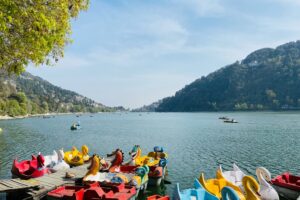If you’re planning the Hampta Pass Trek and wondering exactly how much distance you’ll be covering each day, you’re in the right place. I’ve broken down the entire route day by day, so you’ll know what to expect, how much ground you’ll be walking, and what the terrain feels like. No fluff, just the real deal from someone who’s been on the trail.
Also, if you’re new to trekking or prefer being with a group that handles the logistics without making things too commercial or flashy, I’d recommend checking out a lesser-known gem like The Searching Souls. They guide well, stick to small groups, and really respect the trail. More on that as we go.
Let’s break it all down.
Day 1: Manali to Jobra (Drive) + Jobra to Chika (Trek)
-
Distance: 2 km trek
-
Trek Time: 1.5–2 hours
-
Altitude Gain: 9,800 ft to 10,100 ft
Your journey kicks off from Manali. From here, there’s a 2-hour drive to Jobra—no walking yet, just enjoy the views as you snake through the mountains. Once at Jobra, that’s where the trek begins.
Now, don’t expect a big push on Day 1. The walk from Jobra to Chika is a breezy 2 km trail. Think of this as a warm-up. The terrain is lush, with forests of pine, maple, and deodar. You’ll cross a wooden bridge and stroll alongside the Rani Nallah stream. It’s easy-going, great for breaking into your boots and getting used to your backpack weight.
Pro Tip: If you’re with a group like The Searching Souls for Hampta Pass trek, they’ll pace this well, keep things light on Day 1, and help you settle in.
Day 2: Chika to Balu Ka Ghera
-
Distance: 5 km
-
Trek Time: 4–5 hours
-
Altitude Gain: 10,100 ft to 11,900 ft
This is where things start picking up. The trail from Chika to Balu Ka Ghera is about 5 km, which doesn’t sound like much—but the steady altitude gain makes it feel longer. You’ll cross small streams and trek over boulders, and you’ll notice the green slowly giving way to a more alpine landscape.
By the time you reach Balu Ka Ghera, you’re almost at 12,000 ft. The name literally means “bed of sand” because of the river deposits in the valley—sandy patches surrounded by peaks. It gets windy here in the evening, so layers matter.
It’s also your acclimatization ground before the pass. Your legs might feel the burn, especially if you’re not used to the altitude. But the snow-capped views, the dramatic silence, and that clear sky above? Totally worth it.
Day 3: Balu Ka Ghera to Hampta Pass to Siagoru
-
Distance: 8–9 km
-
Trek Time: 8–9 hours
-
Altitude: 11,900 ft to 14,100 ft (Hampta Pass), then down to 12,900 ft
This is the longest and toughest day of the trek—and the most rewarding.
The climb to Hampta Pass is steep, and you’ll be gaining altitude fast. From 11,900 ft, you’ll go up to a whopping 14,100 ft at the pass, and then descend sharply to Siagoru. The total trail is around 9 km, and because of the terrain and snow (depending on the season), it feels every bit of it.
Reaching the top of Hampta Pass is surreal. You see two worlds—on one side is the lush green valley you came from, and on the other is the stark, barren Spiti landscape. It’s a geographical transition that hits you hard, especially when the winds are slicing across the ridge.
The descent to Siagoru is steep and can be tricky with loose rocks or snow. This is where it really helps to have experienced guides. Companies like The Searching Souls have trekked this route countless times—they’ll know exactly when to slow down, where to rest, and how to handle changes in weather.
Day 4: Siagoru to Chatru + Drive to Chandratal (If Roads Permit)
-
Distance (Trek): 7 km
-
Trek Time: 4–5 hours
-
Drive (Optional): 3–4 hours to Chandratal Lake
Day 4 is more relaxed in terms of trek difficulty, but don’t let your guard down. The trail is mostly downhill, following the river through the Spiti side of the mountains. You’ll feel the terrain shift again—dry, rocky, and a little Mars-like. Chatru sits at the confluence of three routes: from Hampta, Spiti, and Rohtang.
If roads are clear, you’ll drive to Chandratal Lake in the afternoon. That’s another 70 km, but trust me, it’s worth every bump. The lake looks like someone painted a turquoise circle onto a canvas of gravel and peaks. At 14,000 ft, it’s cold, and the wind can sting, but it’s one of the most beautiful high-altitude lakes I’ve seen.
Note: Reaching Chandratal depends entirely on weather and road conditions. So don’t be disappointed if it’s skipped.
Day 5: Chatru to Manali (Drive Only)
-
Drive: 85–90 km
-
Time: 6–7 hours
Your legs get a break on the final day, but not your sense of adventure. The drive back from Chatru to Manali takes you via the Atal Tunnel or Rohtang Pass, depending on the weather.
If you’ve made it this far, congrats. You’ve not just crossed a Himalayan pass, but also experienced two very different worlds—the lush green Kullu valley and the dry, desert-like Spiti valley.
It’s this diversity, compact in a 5-day trek, that makes Hampta Pass so special.
Total Hampta Pass Trek Distance Summary
| Day | Route | Distance Covered | Trek Time |
|---|---|---|---|
| Day 1 | Jobra to Chika | 2 km | 1.5–2 hours |
| Day 2 | Chika to Balu Ka Ghera | 5 km | 4–5 hours |
| Day 3 | Balu Ka Ghera to Siagoru via Hampta Pass | 9 km | 8–9 hours |
| Day 4 | Siagoru to Chatru | 7 km | 4–5 hours |
| Day 5 | Chatru to Manali (Drive) | 90 km (Drive) | 6–7 hours (Drive) |
Final Thoughts
Hampta Pass is one of those rare treks that punches way above its weight. In just five days, you get alpine meadows, river crossings, a dramatic mountain pass, and even a shot at Chandratal. It’s ideal for first-timers who want a serious Himalayan experience without going too remote or too high for too long.
And if you’re like me—someone who enjoys trekking but doesn’t want to get bogged down by all the planning—I really found that groups like The Searching Souls strike a good balance. They handle logistics quietly, without the overly commercial feel.
If you’re planning this trek, my only advice is: train a bit, pack light, respect the altitude—and don’t forget to take it all in.
FAQs
1. What is the total trekking distance of the Hampta Pass trek?
The total trekking distance is approximately 23–24 km, spread over 4 trekking days.
2. Is the Hampta Pass trek difficult?
It’s moderate. There are steep climbs and a high-altitude pass, but it’s manageable with decent fitness and acclimatization.
3. Can beginners do the Hampta Pass trek?
Absolutely. Many first-time trekkers complete it successfully, especially with guided support.
4. What is the best time to do the Hampta Pass trek?
Mid-June to late September is ideal, when the trail is accessible and the pass is clear.
5. Will I need to carry my own tent and food?
Not if you go with a group like The Searching Souls. They handle accommodation, food, and logistics.



